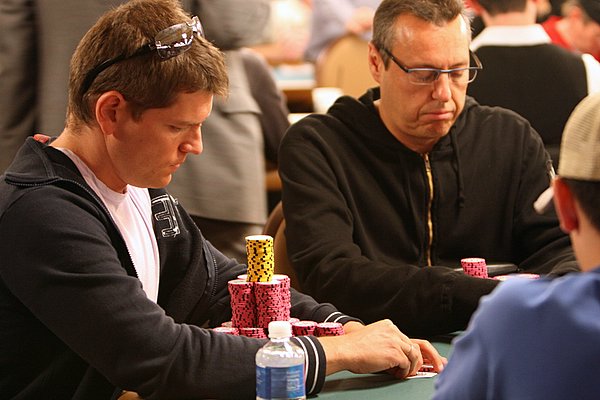Anyone who has played more than a few hands of No-Limit Hold'em has undoubtedly heard the mantra "Position is critical."
But few truly understand why it's so important - or more specifically, in what situations and in what ways position most impacts a No-Limit Hold'em game.
You'll find several situations in No-Limit where the relative position of the players in the hand has a significant impact - both on the way the hand is played and on the outcome. In particular when:
- Flopping a set
- Playing drawing hands
- Playing difficult or trap hands (controlling the size of the pot)
- Looking for bluffing opportunities
- Playing the turn
How to Play Position in No-Limit Holdem
If you want to be a successful No-Limit Hold'em player, understanding position is absolutely essential. So with that in mind, it seems appropriate to devote a series of articles to some of the subtleties of positional play.
Part I: The Impact of Position When You Flop a Set
For the sake of simplicity, we'll restrict our analysis to heads-up pots and discuss some of the differences in the play of the hand depending on whether you are in or out of position.
Building a Pot When You Are Out of Position Is Tricky
Generally speaking, the worst time to try and play a small pocket pair is in one of the blinds facing a raise from a player in late position. Heads-up, in a raised pot, it's difficult to win enough money when you do flop a set to compensate for the money you lose when you don't.
So if you are fortunate enough to flop a set but are out of position, how do you build the pot? There's no easy approach.
If you check-call the flop, it will tend to signal more strength to your opponent than simply calling in position. If you check-raise the flop, you may scare off your opponent altogether and will only earn one small bet.
If you do decide to check-call the flop, you still have to figure out the best course of action on the turn. Checking may lead to your opponent checking behind you, getting no more money into the pot. Check-raising the turn (if your opponent bets) will signal strength, and likely only win you a modest-sized pot. The only other reasonable alternative is to lead out on the flop.
Unfortunately, many good players are now familiar with this move and may proceed cautiously. Even if betting out on the flop does get your opponent to raise, if you call all sorts of alarm bells will be going off. Similarly, if you lead out on both the flop and the turn, it also looks suspicious.
Simply put, there is no reliable way to get a lot of money into the pot when you're out of position. Generally, when faced with this situation, I would advocate betting out and then (possibly) trying to check-raise the turn.
If You Were the Pre-flop Raiser
It's somewhat easier to get money in the pot if you're the pre-flop raiser. Imagine you raise from the cut-off with pocket eights. The button calls and the flop is J♦ 8♠ 3♥. Your goal, of course, is to try and maximize the size of the pot. So how can you do that?
Since you raised pre-flop, the most natural play is to bet the flop. Typically, bet the same amount as you would with a normal continuation bet - somewhere around half to two-thirds of the pot. This may get your opponent to raise if he thinks you've missed the flop.
But let's assume your opponent only calls and the turn is the 6♣.
As is often the case in poker, choosing the best course of action depends on your read of the hand your opponent is most likely to have. Typically, on this sort of flop, your opponent will have one of three types of hands: top pair (usually with a modest kicker, such as J-9 or J-T, since he didn't raise on the flop), a pocket pair lower than the jack, or some type of straight draw (usually the T-9).
If you bet again, will your opponent call with top pair and a medium kicker? How about with a medium pair? If you check, will he bet?
Generally speaking, it's hard to get paid in this sort of scenario. You don't want to give a free card on the straight draw, but you also don't want to scare off an opponent with a medium pocket pair or top pair and a modest kicker (as the former has two outs at best and the latter is now drawing dead).
Flopping a Set in Position Is Far More Profitable
When you flop a set in position, it's much easier to get money in the pot. Consequently, it's also way more profitable to play small and medium pocket pairs from late position.
But there's another reason to prefer playing pocket pairs in position - you can more accurately judge when the pot will be multi-way rather than heads-up. It's still generally profitable to play most pocket pairs heads-up (when in position), but it's far more profitable to play them against two or three opponents.
The primary reason for this is not, as many players tend to think, that more people are putting money in the pot pre-flop and you're getting better odds to flop a set. It's that the size of the bets on the flop, turn and river tend to be multiples of the pot.
If four players see the flop instead of two, the bets on the flop and turn will tend to be much larger.
If You Raise Pre-Flop
If you raise pre-flop and flop a set in position, you're obviously in a very profitable situation.
Let's suppose once again you've raised with pocket eights and the flop comes J♦ 8♠ 3♥. If your opponent bets, you have two good options to build the pot: you can put in a normal raise, or call and wait until your opponent acts on the turn.
If your opponent bets again, you'll have to decide whether it's best to raise on the turn (it usually is if there's any draw on board), or simply smooth-call again and wait to see how things develop on the river.
In either case, you don't have to worry about scaring off your opponent by firing two (or three) barrels from out of position, or by check-calling the flop and then betting (or trying to check-raise) the turn. Instead, simply let the action come to you.
If Your Opponent Raises Pre-Flop
This is one of the most profitable scenarios in Hold'em. Your opponent raises pre-flop and you call in position. You flop a set and your opponent must act first. Because your opponent was the aggressor pre-flop, he'll typically make a continuation bet on the flop. This gives you a couple of good options to build a pot.
Against a solid, aggressive player, it's sometimes best to raise immediately on the flop - especially if the flop is ragged, with no high cards. This will sometimes get your opponent to try and represent a big pair and shut you out with a large re-raise.
Of course, if he actually has the big pocket pair, he will also typically re-raise. This approach will generally work best against a good, aggressive player. Another attractive option is to simply smooth-call the flop and wait for the turn to make your move.
Remember, flopping a set with a pocket pair is one of the most profitable situations in Texas Hold'em. Being slightly more selective with your small and medium pocket pairs and utilizing strong positional play, you can maximize your profits and potentially eliminate a costly leak in your game.
In the next article, we'll take a look at the role of position in the play of drawing hands.






Good article